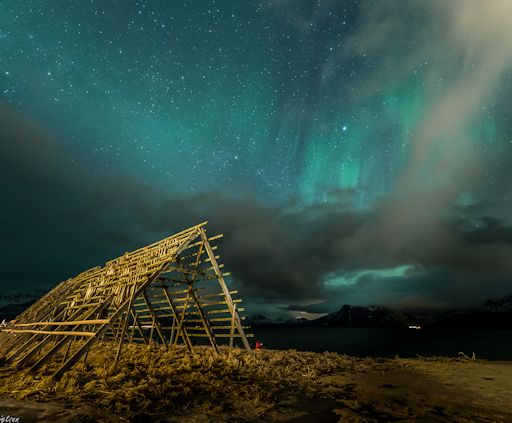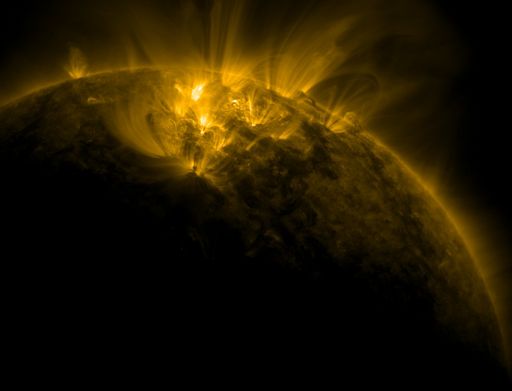When is the best time to see auroras? Where is the best place to go? And how do you photograph them? These questions and more are answered in a new book, Northern Lights - a Guide, by Pal Brekke & Fredrik Broms. | | | HELIOPHYSICS SUMMER SCHOOL: Are you an undergraduate physics or astronomy instructor? There might be a seat waiting for you at the 2014 Heliophysics Summer School. The program's sponsor, UCAR, is looking for a number of qualified instructors to attend with most expenses paid. Apply here. The deadline has been extended to March 22nd. THE AFTERGLOW: Earth's polar magnetic field is still alight with auroras following the CME impact of Feb. 27th. The strongest displays have faded, but the afterglow is beautiful, too: 
Harald Albrigtsen took the picture on March 1st from Kvaløya island in Tromsø, Norway. Onlooker Anne Birgitte Fyhn describes the scene: "After a cloudy evening the sky started turning clear after midnight. We watched these quiet, green auroras above some fish-racks at a local beach." NOAA forecasters estimate a 25% chance of more geomagnetic storms on March 1-2 as CME effects subside. Arctic sky watchers, enjoy the afterglow! Aurora alerts: text, voice Realtime Aurora Photo Gallery SPRING SDO ECLIPSE SEASON BEGINS: Twice every year, around the time of the equinoxes, Earth can pass directly between the Sun and NASA's Solar Dynamics Observatory (SDO), producing a series of beautiful eclipses. SDO's vernal eclipse season began on Feb. 27th, producing a near-total blackout of the sun: 
For the next three weeks these eclipses will repeat once a day around 07:30 UT. At the beginning of the season, the eclipses are short, only a few minutes long. Their duration increases to 72 minutes, mid-season, before tapering off to minutes again as the season winds down. Because most eclipses are relatively short, there is still plenty of uninterrupted time for SDO to monitor activity on the sun. Researchers estimate a scant 2% data loss averaged over the weeks ahead. The ongoing eclipse season will end in late March. Between now and then, stay tuned for some rare blackouts. Realtime Space Weather Photo Gallery
Realtime Comet Photo Gallery
Every night, a network of NASA all-sky cameras scans the skies above the United States for meteoritic fireballs. Automated software maintained by NASA's Meteoroid Environment Office calculates their orbits, velocity, penetration depth in Earth's atmosphere and many other characteristics. Daily results are presented here on Spaceweather.com. On Mar. 1, 2014, the network reported 6 fireballs.
(6 sporadics) 
In this diagram of the inner solar system, all of the fireball orbits intersect at a single point--Earth. The orbits are color-coded by velocity, from slow (red) to fast (blue). [Larger image] [movies]
Potentially Hazardous Asteroids ( PHAs) are space rocks larger than approximately 100m that can come closer to Earth than 0.05 AU. None of the known PHAs is on a collision course with our planet, although astronomers are finding new ones all the time. On March 1, 2014 there were 1460 potentially hazardous asteroids. Notes: LD means "Lunar Distance." 1 LD = 384,401 km, the distance between Earth and the Moon. 1 LD also equals 0.00256 AU. MAG is the visual magnitude of the asteroid on the date of closest approach. | | The official U.S. government space weather bureau | | | The first place to look for information about sundogs, pillars, rainbows and related phenomena. | | | Researchers call it a "Hubble for the sun." SDO is the most advanced solar observatory ever. | | | 3D views of the sun from NASA's Solar and Terrestrial Relations Observatory | | | Realtime and archival images of the Sun from SOHO. | | | from the NOAA Space Environment Center | | | the underlying science of space weather | | 
